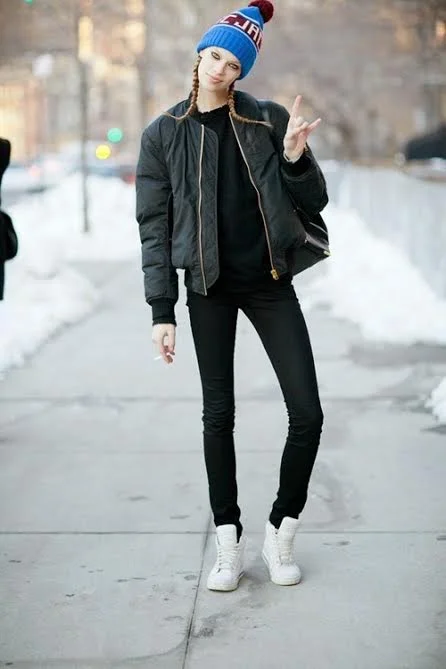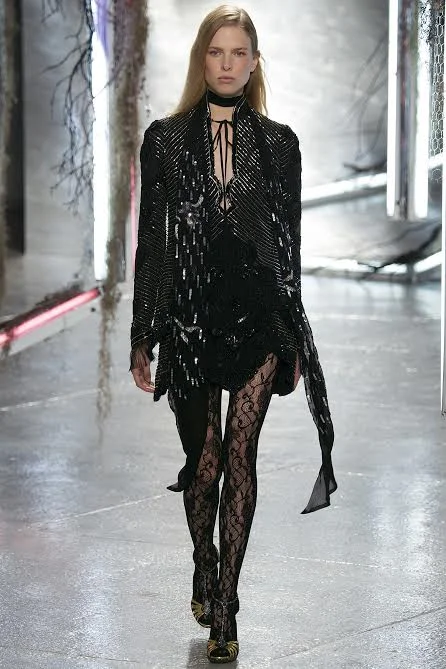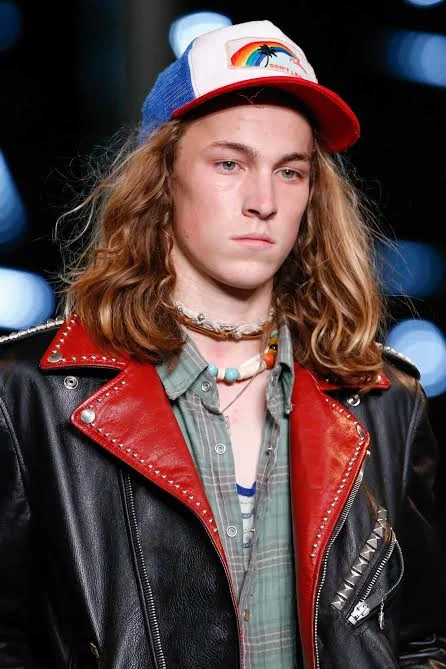From Normcore to Chaos Magic: Fashion's Latest Big Shift
For every action, there is an opposite and equal reaction. So goes Sir Isaac Newton’s third law of motion. Fashion is apparently very much like physics because for every trend (or concept or movement, depending on your choice of semantics), there, too, is an opposite and equal reaction.
The term “normcore” popped up in the fashion lexicon in the fall of 2013. New York- and Los Angeles-based trend forecasting group K-Hole coined it as a “concept,” not a trend, explaining, “Normcore moves away from a coolness that relies on difference to a post-authenticity that opt into sameness.” That’s a lot of words for something that looks so simple. Defined as “bland anti-style,” normcore in its heyday, which was the duration of 2014, represented a charged rejection of "notice me, look at me" trends, flamboyant silhouettes, high-powered accessories (or pretty much any accessories, for that matter), and vivid-bright colors, for a conscious return to basics in the most literal and deliberate sense of the word basic.
Over six months later, it had gained traction. Everything allegedly ordinary, nondescript, and plain was worth coveting. This included mom jeans, traditional New Balance and all-white Nike sneakers, white button-down shirts, monochrome tees and ribbed tanks (preferably Hanes or Fruit of the Loom), lace-free slip dresses, generic track pants, Birkenstocks and other sensible sandals, socks (because they're comfortable), peacoats, army jackets, fleece sweatshirts, plaid flannel, plenty of cotton, and traditional household brand names. The acceptable color palette consisted almost strictly of navy, black, white, khaki, brown, heather gray, forest and military green, and classic denim blue. Unfussy, unadorned, borderline androgynous, sometimes vaguely preppy: It was to be considered a palate cleanser for your wardrobe. Just don't think the look was worn without irony or intention.
What made normcore “cool” was its conscious lack of coolness. Applying effort to look effortless: This is an age-old theme for many when it comes to getting dressed. (Just look at the Kate Moss effect. For years, countless young women have attempted to recreate her aspirational brand of stylish nonchalance.) It was deliberate in its anti-distinctiveness. If there’s any doubt this embracing of all things simplistic, uniform really, signified a bona fide shift in the way people dressed, if only for a moment in time, you need only look to the Gap’s David Fincher-directed ads, released in the spring of 2014. "Dress normal" they commanded, followed by taglines like, "Dress like no one's watching" (whatever the hell that means), "Get caught wearing the same thing," and "Let your actions speak louder than your clothes.” It's almost as if the Gap had the thought: "Hey, wait a minute, we've been making the clothes that are now apparently 'trendy' all along. Let's not only hop on the bandwagon but reclaim it for ourselves."
One could argue this whole normcore fuss was simply nineties minimalism experiencing a renaissance, which it most certainly is; has been for a while now. The clean, pared-down aesthetics of Jil Sander, Calvin Klein, and Helmut Lang come to mind, though theirs can feel almost highbrow in comparison to this purposefully pedestrian mode of dressing. Essentially, the people who were children and teens in the nineties are going back to the clothes they wore as kids.
Maybe we got sick of the onslaught of visual noise and clunk and junk. Maybe we remembered it feels good to look clean. Maybe we became a little socialist in spirit, realizing the more similarly we all dress, the more our individual personalities can shine through (which seems counterintuitive, though the notion is not without merit). Eh, doubtful. Here’s the thing: the rejection of trends can itself be a trend. The fact remains that by rejecting the selection of a persona defined by your clothes, you are, in fact, electing a persona, even if that persona claims, "Hey, non-fashion person, I'm just like you! Only a little better because I am dressing like this on purpose. And you're not." When a mode of dressing becomes a “thing,” even if that’s the intention, it’s only a matter of time before the pendulum swings in the other direction.
Enter the flipside. Looking like everybody else, or a tourist from the Midwest who frequents Sears, for that matter, evidently gets old fast, and in September, K-Hole coined a new term to encapsulate the latest shift. “Things were mopey in the K-Hole offices,” begins the agency’s fifth report http://khole.net/issues/05/, and the only thing to turn their drowsy moods around was something called “Chaos Magic.” Apparently, the same goes for fashion’s mood. More spiritual and less literal than old-fashioned, rabbit-out-of-the-hat magic, it’s founded on manifestations, self-expression, and personal choice. Toss in elements of The Secret, DIY taken to the extreme, and the power of belief, and, voila, you’ve got Chaos Magic.
“Mixing your own Kool-Aid, deciding how strong to make it, knowing when to drink it and when to stop, is Chaos Magic in practice,” says K-Hole’s report. “Chaos Magic is what happens after will. It’s the antidote to the tryhard probems that come with overthinking everything. If you really want to change, you have to go deeper.” If normcore is cold and analytical, Chaos Magic is warm and emotional. It can be illustrated by acts as simple as dancing all night long or laughing with friends. Or, as the report suggests, you can take a more extreme approach. “Fuck someone wearing Chanel, stare at the label while you’re cumming, and you’ll become Karl Lagerfeld. Chaos Magic, like branding, is desire doomed to be commercial.”
So how does this translate to the way we dress? For one thing, modern-day fashion, and the concepts that come with it, is “desire doomed to be commercial,” if nothing else. For another, shopping for clothes and selecting our ensembles – which, in turn, translate to the personas with which we present ourselves to the rest of the world, only to reap the consequences – are emotional acts for many, much as we might deny it. Normcore was an outright denial of this truth. This motion away from traditional logic puts the gusto, hot-bloodedness, and mania back into the routine of getting dressed. Moreover, it has the potential to turn the routine on its head.
Chaos Magic instructs us to put the experience back in the very experience of dressing ourselves, so to speak. Or at least its most visceral aspects. For proof, we need only look to the Spring ’16 runways, which seemed an exercise in under-thinking and indulging in feelings. At Rodarte, co-designer Kate Mulleavy noted, “Sometimes I feel like it’s futuristic to go into the past.” She and her sister blended glam-rock shine and sparkle with endless strips of intricate lace, inspired by the poetry of Emily Dickinson and Elisabeth Barrett Browning. The theme of Rei Kawakubo’s Comme des Garçons show was “Blue Witches,” described as “powerful women who are misunderstood, but do good in the world.” Blue Witches wear outlandishly sculptural pieces one could not rightfully classify as clothes, and that’s the idea.
Master commoditizer Hedi Slimane of Saint Laurent pushed the whimsical, if not entirely infantile notion of pairing a pair of denim overall shorts with a bedazzled tiara, along with a matching beaded velvet bomber jacket. Actually, he paired just about every look in his collection with a dainty princess tiara. House-of-the-moment Vetements delivered sporty sweatshirts draped dramatically (and seemingly thoughtlessly) over slips, along with a few Technicolor dresses so striking they dare you to wear them more than just once. Which you should. This is about doing whatever you want.
Plus, the Spring 2016 runways suggest a return to the “so bad its good” inclinations of the very late nineties to early 2000s. The only explanation for the return of the trucker hat, as seen at Saint Laurent’s menswear show; allover fishnet layers, as per Louis Vuitton; and colorful mini-bags so miniscule they barely fit into the category of change purse (Fendi is the biggest proponent of tiny accessories) is the fact we’re answering our basest impulses, unencumbered by logic – and possibly good taste. Not that there’s anything wrong with that. Good taste can be a real snooze. So plunge forward into the future, manifest your destiny, and make no apologies for that optimistically hideous trucker hat on your head.









